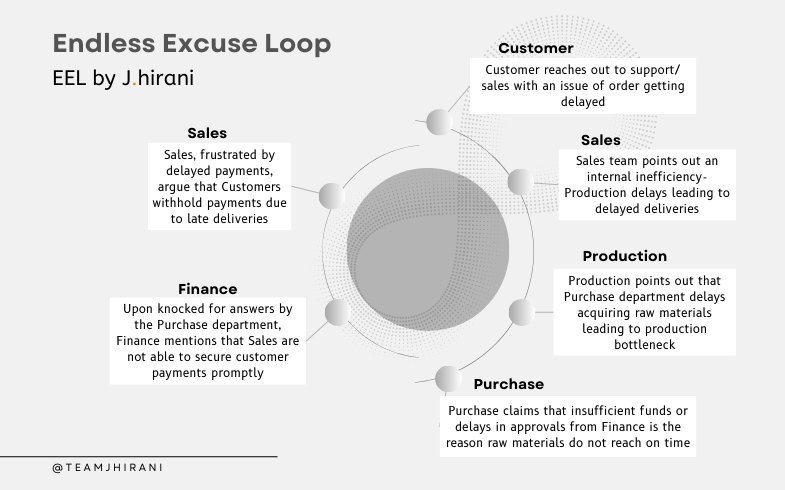Success is not solely attributable to individual efforts but is the result of collaboration, cooperation, and shared contributions from multiple parties working towards a common goal. Efficient organizations share their success or accomplishments collectively as a group, team or community.
The following example underscores how divergent department goals create inefficiencies in organizations.
An organization often faces customer complains about orders not being delivered on time. Sales teams attribute delays to issues in the supply chain, citing production delays. Production, in turn, blames delays on the late procurement of raw materials. The purchasing department points fingers at finance, claiming insufficient funds or delays in approvals. Finance, however, blames sales for not securing customer payments promptly. Sales, frustrated by delayed payments, argue that customers withhold payments due to late deliveries. This cycle of blame perpetuates inefficiency. Implementing cross-functional goals, similar to those in Scrum methodology, is crucial to break this loop and promote collaboration across departments.
Scrum promotes adaptability and flexibility, allowing teams to respond to changing requirements and customer feedback quickly. But how to implement Scrum effectively? Scrum demands that a few things be practiced like transparency in process, cross functional goals and incremental meetings of experts on goal driven achievements.
LET’S understand how to implement SCRUM linking it to FOOTBALL.
Sports are effective examples for learning team values and goal setting. In Football all players assume their different roles. Some positions are defensive, some offensive, which are all allocated based on the capabilities of different individual players. The players often assemble and talk in between the game- to discuss what each position will have to do in order to achieve the objectives. These different players work towards a single goal for success- they want to win.
Just like this, in an organization, differently capable individuals are given job positions relevant to their education, learning and experience. Generally, inefficient organizations have different department goals. Such structures are inadequate. In order for a business to win games just like football, we need to rethink on organization structure designs if they are leading to isolated departments goals and activities.
TIME to design Hybrid structures.

Cross functional goals are at the Core of Scrum leading to better planning and transparency in processes. A hybrid model is where individuals are connected based on functional expertise; creating groups centered around focused goals, aligning KRAs of functional heads directly with organizational objectives. It acknowledges that Goals must be cross functional goals.
HOW TO GOALS
An Example
If an organization has 3 goals- 1. Penetrating the market 2. Keeping healthy cashflow 3. Making good profits; all functional heads should have these as their primary goals.
1. Penetrating the market

A sales Scrum team would collaborate on various tasks and strategies to achieve this objective. This can involve individuals from different departments like sales, marketing, sales support, product, etc. and perform following functions.
Market Analysis and Research:
The team collaborates to research the target market, identifying potential customers, competitors, and market trends.
They analyze data to understand customer needs, pain points, and preferences, which will inform their sales approach.
Lead Generation:
Marketing representatives and sales development representatives work together to generate leads through various channels such as email campaigns, social media outreach, networking events, and cold calling.
They prioritize leads based on their potential to contribute to market penetration.
Product Development Alignment:
The sales team collaborates with product development or product management to ensure that their sales efforts align with the features and benefits of the product.
They provide feedback on customer requirements and market demands to inform product development decisions.
Sales Strategy Formulation:
Sales representatives, together with sales managers and possibly marketing representatives, devise sales strategies tailored to penetrate the target market.
They define target customer segments, value propositions, pricing strategies, and sales tactics to effectively reach and convert prospects.
Customer Engagement and Relationship Building:
Sales representatives engage with potential customers through personalized interactions, product demonstrations, presentations, and follow-up communication.
They focus on building relationships and addressing customer needs to establish trust and credibility in the market.
Collaborative Sales Pipeline Management:
The team collaborates on managing the sales pipeline, tracking leads and opportunities through various stages of the sales process.
They use tools like CRM (Customer Relationship Management) software to ensure visibility and transparency across the team.
Supply Chain Planning
Team on the supply chain side ensure that appropriate inventories are available in line with the demands forecasting through inputs gained from CRM relating to pipeline and leads.
Continuous Monitoring and Optimization:
The team continuously monitors their progress towards market penetration goals, analyzing key metrics such as conversion rates, customer acquisition costs, and market share.
They identify areas for improvement and adjust their strategies and tactics accordingly, leveraging insights gained from ongoing feedback and data analysis.
Regular Review and Adaptation:
The team holds regular review meetings, such as sprint reviews and retrospectives, to evaluate their performance and adapt their approach as needed.
They celebrate successes, address challenges, and iterate on their strategies to drive continuous improvement in market penetration efforts.
In conclusion, sales isn’t just about taking orders; it’s about ensuring timely supply—a principle deeply rooted in the Scrum methodology. In a cross-functional team setup, every member shoulders the responsibility of various functions, working together to capture and fulfill customer orders. But until the order is delivered on time, goal remains unachieved. This shift in perspective underscores the pivotal roles of sales and cross functional teams in delivering exceptional customer experiences and driving business success.
Topic coined by Parth Hirani compiled by Shivani Buch
J.hirani provides strategic advisory services to manufacturing, service brands, product brands, online/ offline business. Read our capabilities.



